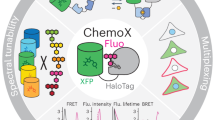Abstract
Fluorescent biosensors can report on the relative abundance, activity, or conformation of biomolecules and analytes through changes in fluorescence emission. A wide variety of genetically-encoded and synthetic biosensors have been developed to monitor protein kinase activity. We have focused on the design, engineering and characterization of fluorescent peptide biosensors of cyclin-dependent kinases (CDKs) that constitute attractive cancer biomarkers and pharmacological targets. In this chapter, we describe the CDKACT fluorescent peptide biosensor technology and its application to assess the relative kinase activity of CDKs in vitro, either using recombinant proteins or cell extracts as a more complex source of kinase. This technology offers a straightforward means of comparing CDK activity in different cell lines and evaluating the specific impact of treatments intended to target kinase activity in a physiologically relevant environment.
Access this chapter
Tax calculation will be finalised at checkout
Purchases are for personal use only
Similar content being viewed by others
References
Morris MC (2014) Spotlight on fluorescent biosensors—tools for diagnostics and drug discovery. ACS Med Chem Lett 5:99–101. https://doi.org/10.1021/ml400472e
Nhu Ngoc Van T, Morris MC (2013) Fluorescent sensors of protein kinases: from basics to biomedical applications. In: Morris MC (ed) Progress in molecular biology and translational science. Academic, Cambridge, MA, pp 217–274
González-Vera JA, Morris MC (2015) Fluorescent reporters and biosensors for probing the dynamic behavior of protein kinases. Proteomes 3:369–410. https://doi.org/10.3390/proteomes3040369
Pazos E, Vázquez O, Mascareñas JL, Vázquez ME (2009) Peptide-based fluorescent biosensors. Chem Soc Rev 38:3348–3359. https://doi.org/10.1039/B908546G
Zhang J, Campbell RE, Ting AY, Tsien RY (2002) Creating new fluorescent probes for cell biology. Nat Rev Mol Cell Biol 3:906–918. https://doi.org/10.1038/nrm976
Ibraheem A, Campbell RE (2010) Designs and applications of fluorescent protein-based biosensors. Curr Opin Chem Biol 14:30–36. https://doi.org/10.1016/j.cbpa.2009.09.033
Palmer AE, Qin Y, Park JG, McCombs JE (2011) Design and application of genetically encoded biosensors. Trends Biotechnol 29:144–152. https://doi.org/10.1016/j.tibtech.2010.12.004
Wang Q, Zimmerman EI, Toutchkine A et al (2010) Multicolor monitoring of dysregulated protein kinases in chronic myelogenous leukemia. ACS Chem Biol 5:887–895. https://doi.org/10.1021/cb100099h
Luković E, González-Vera JA, Imperiali B (2008) Recognition-domain focused chemosensors: versatile and efficient reporters of protein kinase activity. J Am Chem Soc 130:12821–12827. https://doi.org/10.1021/ja8046188
Yeh R-H, Yan X, Cammer M et al (2002) Real time visualization of protein kinase activity in living cells. J Biol Chem 277:11527–11532. https://doi.org/10.1074/jbc.M111300200
Turner APF (2013) Biosensors: sense and sensibility. Chem Soc Rev 42:3184–3196. https://doi.org/10.1039/C3CS35528D
Lavis LD, Raines RT (2008) Bright ideas for chemical biology. ACS Chem Biol 3:142–155. https://doi.org/10.1021/cb700248m
Loving GS, Sainlos M, Imperiali B (2010) Monitoring protein interactions and dynamics with solvatochromic fluorophores. Trends Biotechnol 28:73–83. https://doi.org/10.1016/j.tibtech.2009.11.002
Van TNN, Pellerano M, Lykaso S, Morris MC (2014) Fluorescent protein biosensor for probing CDK/cyclin activity in vitro and in living cells. Chembiochem 15:2298–2305. https://doi.org/10.1002/cbic.201402318
Prével C, Pellerano M, González-Vera JA et al (2016) Fluorescent peptide biosensor for monitoring CDK4/cyclin D kinase activity in melanoma cell extracts, mouse xenografts and skin biopsies. Biosens Bioelectron 85:371–380. https://doi.org/10.1016/j.bios.2016.04.050
González-Vera JA, Bouzada D, Bouclier C et al (2017) Lanthanide-based peptide biosensor to monitor CDK4/cyclin D kinase activity. Chem Commun 53:6109–6112. https://doi.org/10.1039/C6CC09948C
Peyressatre M, Laure A, Pellerano M et al Fluorescent biosensor of CDK5 kinase activity in glioblastoma cell extracts and living cells. Biotechnol J 15:e1900474. https://doi.org/10.1002/biot.201900474
Soamalala J, Diot S, Pellerano M et al Fluorescent peptide biosensor for probing CDK6 kinase activity in lung cancer cell extracts. ChemBioChem 22(6):1065-1071.https://doi.org/10.1002/cbic.202000677
Morgan DO (1997) Cyclin-dependent kinases: engines, clocks, and microprocessors. Annu Rev Cell Dev Biol 13:261–291. https://doi.org/10.1146/annurev.cellbio.13.1.261
Malumbres M, Barbacid M (2005) Mammalian cyclin-dependent kinases. Trends Biochem Sci 30:630–641. https://doi.org/10.1016/j.tibs.2005.09.005
Malumbres M, Barbacid M (2007) Cell cycle kinases in cancer. Curr Opin Genet Dev 17:60–65. https://doi.org/10.1016/j.gde.2006.12.008
Asghar U, Witkiewicz AK, Turner NC, Knudsen ES (2015) The history and future of targeting cyclin-dependent kinases in cancer therapy. Nat Rev Drug Discov 14:130–146. https://doi.org/10.1038/nrd4504
Peyressatre M, Prével C, Pellerano M, Morris MC (2015) Targeting cyclin-dependent kinases in human cancers: from small molecules to peptide inhibitors. Cancers (Basel) 7:179–237. https://doi.org/10.3390/cancers7010179
Lapenna S, Giordano A (2009) Cell cycle kinases as therapeutic targets for cancer. Nat Rev Drug Discov 8:547–566. https://doi.org/10.1038/nrd2907
Malumbres M, Barbacid M (2001) To cycle or not to cycle: a critical decision in cancer. Nat Rev Cancer 1:222–231. https://doi.org/10.1038/35106065
Arooz T, Yam CH, Siu WY et al (2000) On the concentrations of cyclins and cyclin-dependent kinases in extracts of cultured human cells. Biochemistry 39:9494–9501. https://doi.org/10.1021/bi0009643
Acknowledgments
This work was supported by the CNRS (Centre National de la Recherche Scientifique) and a grant from the Region Occitanie and European Regional Development Fund (READYNOV/FEDER n° 2018-003539-01) to M.C. Morris. We acknowledge GL Biochem (Shanghai, China) Ltd. and GENEPEP (St-Jean de Védas, France) for synthesis of peptide biosensors. We thank all former members of the “Kinase Biosensors & Inhibitors” group for their contributions to development of fluorescent peptide biosensors: T.N.N. Van, C. Prével, M. Peyressatre, J.A. Gonzalez Vera, C. Tilmaciu, Sebastien Diot, Jessica Soamalala and Arthur Laure.
Author information
Authors and Affiliations
Corresponding author
Editor information
Editors and Affiliations
Rights and permissions
Copyright information
© 2021 Springer Science+Business Media, LLC, part of Springer Nature
About this protocol
Cite this protocol
Pellerano, M., Morris, M.C. (2021). Fluorescent Peptide Biosensors for Probing CDK Kinase Activity in Cell Extracts. In: Coutts, A.S., Weston, L. (eds) Cell Cycle Oscillators . Methods in Molecular Biology, vol 2329. Humana, New York, NY. https://doi.org/10.1007/978-1-0716-1538-6_4
Download citation
DOI: https://doi.org/10.1007/978-1-0716-1538-6_4
Published:
Publisher Name: Humana, New York, NY
Print ISBN: 978-1-0716-1537-9
Online ISBN: 978-1-0716-1538-6
eBook Packages: Springer Protocols




